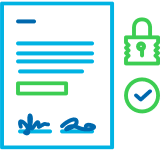
BY SPIRION
April 29, 2025
The National Institute of Standards and Technology (NIST) cybersecurity frameworks and the Cybersecurity Maturity Model Certification (CMMC) establish strict data protection and security controls for organizations handling federal and defense-related sensitive information. These frameworks are critical for businesses working with the U.S. government and Department of Defense (DoD) to safeguard Controlled Unclassified Information (CUI) and other sensitive data.
Many organizations assume that Data Loss Prevention (DLP) solutions are sufficient to comply with NIST 800-171, NIST CSF, and CMMC However, DLP alone is not enough to meet these compliance requirements. Full compliance requires continuous data discovery, classification, access control, and encryption, capabilities that extend beyond what DLP can offer.
This article explores the limitations of DLP for NIST and CMMC compliance and how Spirion’s automated data security solutions help organizations meet regulatory requirements.
Understanding NIST & CMMC Data Protection Requirements
NIST and CMMC frameworks require organizations to identify, classify, and protect sensitive information. Key requirements include:
NIST 800-171 & NIST Cybersecurity Framework (CSF)
- Requirement 3.1: Implement access controls to protect sensitive information.
- Requirement 3.3: Audit data access and maintain security logs.
- Requirement 3.8: Protect sensitive information at rest and in transit.
- Requirement 3.13: Identify and classify Controlled Unclassified Information (CUI).
- Requirement 3.14: Continuously monitor security posture to prevent unauthorized data access.
CMMC Requirements
- Access Control (AC) – Ensures only authorized personnel can access CUI.
- Audit & Accountability (AU) – Requires tracking and logging of data access.
- Identification & Authentication (IA) – Implements strict user authentication and control mechanisms.
- Media Protection (MP) – Ensures proper handling and disposal of sensitive data.
- Risk Management (RM) – Requires ongoing risk assessments and threat detection.
Both frameworks emphasize proactive data discovery, classification, and security controls beyond just monitoring data movement.
Why DLP Alone Is Not Enough for NIST & CMMC Compliance
DLP solutions primarily focus on preventing unauthorized data transfers, but compliance with NIST and CMMC requires a broader, more proactive approach to data governance and protection. Here’s where DLP falls short:
1. DLP Does Not Identify or Classify CUI
NIST and CMMC mandate that organizations identify and classify all sensitive data, including CUI. DLP solutions only monitor data in motion but do not provide visibility into stored sensitive data across endpoints, databases, and cloud storage.
Risk: Without accurate classification, organizations may fail to enforce security policies, leading to non-compliance and increased cybersecurity risks.
2. DLP Cannot Enforce Access Controls on Sensitive Data
NIST and CMMC require organizations to restrict access to sensitive information. While DLP can block unauthorized data transfers, it does not provide the access control mechanisms needed to enforce role-based permissions and user authentication.
Risk: Organizations relying on DLP may fail to meet access control requirements, putting sensitive data at risk of unauthorized access.
3. DLP Does Not Support Audit-Ready Compliance Reporting
NIST and CMMC compliance requires organizations to track and log all interactions with sensitive data. DLP solutions lack detailed audit trails and compliance reporting capabilities.
Risk: Without audit-ready reports, businesses may struggle to demonstrate compliance during assessments and audits.
4. DLP Does Not Apply Persistent Protection to Data at Rest
Both NIST and CMMC require organizations to encrypt and protect sensitive data at rest. DLP solutions focus on monitoring data movement but do not enforce encryption, tokenization, or data masking.
Risk: Organizations using DLP alone may leave sensitive data exposed, increasing the risk of cybersecurity breaches.
5. DLP Generates False Positives, Leading to Compliance Fatigue
DLP solutions frequently misidentify non-sensitive data as violations, overwhelming security teams with unnecessary alerts.
Risk: Compliance teams may overlook critical security threats due to alert fatigue, leading to gaps in data protection.
How Spirion Bridges the NIST & CMMC Compliance Gap
Unlike DLP, Spirion provides automated data discovery, classification, access control, and encryption, ensuring organizations meet NIST and CMMC requirements effectively.
- Automated CUI Discovery: Identifies sensitive data across on-prem, cloud, and remote endpoints.
- Persistent Classification & Labeling: Ensures CUI is accurately tagged and monitored for compliance.
- Role-Based Access Control (RBAC): Helps businesses enforce strict access permissions on sensitive data.
- Encryption & Data Masking: Supports secure storage and transmission of sensitive data.
- Audit-Ready Compliance Reporting: Provides detailed logs and security insights to meet regulatory audit requirements.
- Continuous Monitoring & Risk Assessments: Helps organizations identify security gaps and mitigate risks before they lead to compliance failures.
Final Thoughts: DLP Alone Cannot Ensure NIST & CMMC Compliance
DLP is useful for preventing unauthorized data leaks, but it does not provide the data discovery, classification, encryption, and audit capabilities required for full NIST and CMMC compliance. Organizations relying solely on DLP risk non-compliance, security vulnerabilities, and potential contract loss with government agencies.
With Spirion’s automated CUI discovery, classification, and security controls, organizations can protect sensitive information, reduce compliance risks, and meet NIST & CMMC standards with confidence.
To learn how Spirion can enhance your NIST & CMMC compliance strategy, request a demo today.
